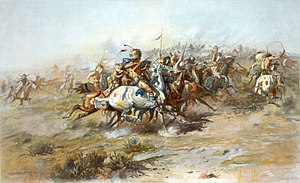
Back Slag van Little Bighorn Afrikaans Batalla de Little Bighorn AN معركة لتل بيج هورن Arabic لیتل بیقهورن دؤیوشو AZB Бітва каля Літл-Бігхорн Byelorussian Битка при Литъл Бигхорн Bulgarian Emgann Little Bighorn Breton Batalla de Little Bighorn Catalan Bitva u Little Bighornu Czech Brwydr Little Big Horn Welsh
| Battle of the Little Bighorn | |||||||
|---|---|---|---|---|---|---|---|
| Part of the Great Sioux War of 1876 | |||||||
 The Battle of Little Bighorn by Charles Marion Russell | |||||||
| |||||||
| Belligerents | |||||||
| Commanders and leaders | |||||||
| Units involved | |||||||
| Nations of the plains | 7th Cavalry Regiment | ||||||
| Strength | |||||||
| 1,100–2,500 warriors | c. 700 cavalrymen and scouts | ||||||
| Casualties and losses | |||||||
|
| ||||||
Location within Montana | |||||||


The Battle of the Little Bighorn, known to the Lakota and other Plains Indians as the Battle of the Greasy Grass,[1][2] and commonly referred to as Custer's Last Stand, was an armed engagement between combined forces of the Lakota Sioux, Northern Cheyenne, and Arapaho tribes and the 7th Cavalry Regiment of the United States Army. The battle, which resulted in the defeat of U.S. forces, was the most significant action of the Great Sioux War of 1876. It took place on June 25–26, 1876, along the Little Bighorn River in the Crow Indian Reservation in southeastern Montana Territory.[3]
Most battles in the Great Sioux War, including the Battle of the Little Bighorn, were on lands those natives had taken from other tribes since 1851.[4][5][6][7] The Lakotas were there without consent from the local Crow tribe, which had a treaty on the area. Already in 1873, Crow chief Blackfoot had called for U.S. military actions against the native intruders.[8][9] The steady Lakota invasion (a reaction to white encroachment into the Black Hills) into treaty areas belonging to the smaller tribes[10] ensured the United States a firm Indian alliance with the Arikaras[11] and the Crows during the Lakota Wars.[12][13][14]
The fight was an overwhelming victory for the Lakota, Northern Cheyenne, and Arapaho, who were led by several major war leaders, including Crazy Horse and Chief Gall, and had been inspired by the visions of Sitting Bull (Tȟatȟáŋka Íyotake). The U.S. 7th Cavalry, a force of 700 men, commanded by Lieutenant Colonel George Armstrong Custer (a brevetted major general during the American Civil War), suffered a major defeat. Five of the 7th Cavalry's twelve companies were wiped out, and Custer was killed, as were two of his brothers, his nephew, and his brother-in-law. The total U.S. casualty count included 268 dead and 55 severely wounded (6 died later from their wounds),[15]: 244 including 4 Crow Indian scouts and at least 2 Arikara Indian scouts.
Public response to the Great Sioux War varied in the immediate aftermath of the battle. Custer's widow Libbie Custer soon worked to burnish her husband's memory and during the following decades, Custer and his troops came to be considered heroic figures in American history. The battle and Custer's actions in particular have been studied extensively by historians.[16] Little Bighorn Battlefield National Monument honors those who fought on both sides.
- ^ Davis, J. (2020). "The Battle of Greasy Grass". In Custodia Legis. Library of Congress. Retrieved August 31, 2023.
- ^ "The Battle of the Greasy Grass". Smithsonian. Archived from the original on April 5, 2019. Retrieved December 7, 2014.
- ^ Kappler, Charles J (1904): Indian Affairs. Laws and Treaties. Vol. 2. Washington, pp. 1008–1011.
- ^ Ewers, John C.: "Intertribal Warfare as a Precursor of Indian-White Warfare on the Northern Great Plains". Western Historical Quarterly, Vol. 6, No. 4 (Oct. 1975), pp. 397–410 [408].
- ^ Stands In Timber, John and Margot Liberty (1972): Cheyenne Memories. Lincoln and London. p. 170, note 13.
- ^ Calloway, Colin G.: "The Inter-tribal Balance of Power on the Great Plains, 1760–1850", Journal of American Studies, Vol. 16, No. 1 (April 1982), pp. 25–47 [46].
- ^ White, Richard: "The Winning of the West: The Expansion of the Western Sioux in the Eighteenth and Nineteenth Centuries", The Journal of American History, Vo. 65, No. 2 (Sep. 1987), pp. 319–343 [342].
- ^ Hoxie, Frederick E. (1995): Parading Through History: The making of the Crow Nation in America, 1805–1935. Cambridge, p. 106.
- ^ Annual Report of the Commissioner of Indian Affairs, 1873. Washington, 1874, p. 124.
- ^ Medicine Crow, Joseph (1992): From the Heart of the Crow Country: The Crow Indians' Own Stories. New York. pp. 64–5, 84.
- ^ Dunlay, Thomas W. (1982). Wolves for the Blue Soldiers: Indian Scouts and Auxiliaries with the United States Army, 1860–90. Lincoln and London. p. 132.
- ^ Calloway, Colin G.: "The Inter-tribal Balance of Power on the Great Plains, 1760–1850". Journal of American Studies, Vol. 16, No. 1 (April 1982), pp. 25–47 [46].
- ^ Dunlay, Thomas W. (1982). Wolves for the Blue Soldiers: Indian Scouts and Auxiliaries with the United States Army, 1860–90. Lincoln and London. pp. 112–114.
- ^ Medicine Crow, Joseph (1992): From the Heart of the Crow Country: The Crow Indians' Own Stories. New York. p. xi.
- ^ Scott, Douglas D.; Fox, Richard A.; Connor, Melissa A.; Harmon, Dick (2013) [1989]. Archaeological Perspectives on the Battle of the Little Bighorn. Norman: University of Oklahoma Press. ISBN 978-0-8061-3292-1.
- ^ Kershaw, Robert (2005). Red Sabbath: The Battle of Little Bighorn. Ian Allan Publishing. pp. vi–5. ISBN 978-0-7110-3325-2.
© MMXXIII Rich X Search. We shall prevail. All rights reserved. Rich X Search
